The detail view and its variants
Overview
The detail view in the Documents tab of the project dashboard is an alternative to the list view and is focused on a document.

The upper part of the view is in common with the other views of the Documents tab: on the left the toolbar to switch to the other views (list and analytics) and the name of any selected experiment, then—in the default visualization—the search bar.
The current set of documents is shown in the left panel, with the selected document at the top.
The central area displays the text of the current document.
The selected document is the one that was current in the source view, for example the list view. The current document is the one that is selected in the list of the left and initially coincides with the selected document, then it can be changed by selecting another document from the list.
The right panel lists information about the current document: those obtained from the NLU analysis carried out during document upload, any annotations and—if an experiment has been selected—any output of the experiment model such as categories or extractions.
The list of documents
The list of documents on the left is affected by any search criteria and filters.

Below the button to manage the presence-absence filter, you will find the number of selected documents and two dropdown menus:
- With the first you can filter documents by language.
-
With the second you can sort the list in ascending or descending order with respect to:
- File name
- Relevance to the search criteria
- Number of annotations
- Number of experiment results (categories or extractions)
The document above the list is the selected document. As mentioned before, this is the document that was current in the source view of the Documents tab, which, by default, is the list view.
The list of documents may or may not include the selected document based on current search criteria and filters. This is why the selected document has a marker that indicates whether is present (green marker  ) or absent (red marker
) or absent (red marker  ) in the list.
) in the list.
The language is indicated for each document.
For the documents in the list, information relating to annotation and to the experiment—such as the categories or the number of extractions—is reported below the text abstract. In the case of categories, the first two are shown: if there are more, the number of excess categories preceded by the plus sign is displayed on the right.
Between the selected document and the list there is a box that allows you to filter the list by document name. Type at least three characters, the match is case sensitive. Select the X icon on the right to cancel the filter.
To change the current document, select another document from the list.
When you change the current document, the selected document is unaffected. To change the selected document, double-click a document in the list.
Info
If you change the selected document, it will also become the new current document in the source view.
The entire panel pan be collapsed and expanded again selecting the collapse  and the expand
and the expand  icons at the top right of it.
icons at the top right of it.
The central panel
The central panel shows the text of the current document together with summary information and controls for performing operations on the document.

Below you will find the description of panel elements that are common to all project types and don't have to do with annotation activities. Annotation controls are described in the sections of this manual that pertain to categorization, extraction and thesaurus projects.
First bar
In the default visualization, the topmost bar of the central panel contains:
-
On the left:
- The position of the current document and the total number of documents in the list.
- The controls to move from one document to the next or previous in the list.
- The language of the current document.
- The name of the source file of the current document.
-
On the right:
- (For categorization, extraction and thesaurus projects) Toggle sections
 to toggle the display of document's sections and enable or disable their annotation.
to toggle the display of document's sections and enable or disable their annotation. - Other buttons that are unique to the project type.
- PDF document view
 , when available.
, when available. - Find text
 to find text inside the document (see below).
to find text inside the document (see below). -
An ellipsis button
 that opens a menu. The menu commands that are common to all types of projects are:
that opens a menu. The menu commands that are common to all types of projects are:- Copy to clipboard
 to copy the text of the document to the clipboard.
to copy the text of the document to the clipboard. - Show original text spacing
 to toggle the display of white space—blanks, empty lines—which is present if the original file but is not shown by default.
to toggle the display of white space—blanks, empty lines—which is present if the original file but is not shown by default. - Show condensed document
 : to toggle condensed document view.
: to toggle condensed document view. - Delete document
 to delete the document.
to delete the document.
- Copy to clipboard
-
Open immersive view
 to open immersive view.
to open immersive view. -
Show more
 and Hide details
and Hide details  to show and hide:
to show and hide:- Main sentences
- File size
- Text size
- Upload time author
- Main knowledge graph topics
To filter the list of documents based on the detection of a main topic, double-click the topic. The topic is added to the search criteria in the search box and the list of documents is filtered. Selected topics are highlighted in the list.

- (For categorization, extraction and thesaurus projects) Toggle sections
In immersive and Pdf document views:
- This toolbar merges with the above toolbar and with the presence/absence filter toggle switch in a new toolbar that spans all the width of the page.
- The search bar disappears, but search criteria are still visible inside the presence/absence filter.
To find and highlight all occurrences of a string in the text of the current document:
- Select Find text
 .
. - Enter at least three characters in the Find text box and press
Enter. The match is case insensitive.
To the right of the box the number of matches is displayed. Select the X icon to cancel the operation.
Second bar
In the default visualization, the second horizontal bar from the top in the central panel shows project-type specific controls and, when at least one item is highlighted inside the text, Toggle highlight navigator  .
.

The bar shows counts related to the current experiment (for example, the number of extractions and the metrics) and the number of annotations. Sometimes counts are shown in buttons that act as highlight toggles. The bar can also show annotation controls.
Note
See the dedicated pages in the extraction and thesaurus sections.
To navigate through the highlighted items, select Toggle highlight navigator  .
.
To move the focus to the previous highlight select Focus previous highlight  , to move it to the next highlight select Focus next highlight
, to move it to the next highlight select Focus next highlight  . The document is scrolled to the chosen highlight and all the other highlights are dimmed. The small panel shows the current highlight number compared to the total number of highlights.
. The document is scrolled to the chosen highlight and all the other highlights are dimmed. The small panel shows the current highlight number compared to the total number of highlights.

To go back to the normal display of all the highlights, select Focus all highlights  .
.
In immersive and Pdf document views this bar is not displayed, but in categorization projects some controls and the contents of the fourth bar (see below) are merged in the only remaining bar of the central panel.
Third bar
The third bar from the top in the central panel is unique to categorizations projects and is displayed only in the context of an experiment. It shows output categories and annotated categories.
In immersive and Pdf document views the contents of this bar move to the only remaining bar of the central panel together with the annotation controls from the third bar (see above).
Text area
The text area is where you can read the document, see highlighted information and perform annotation activities for extraction and thesaurus projects.
Its variants, the condensed document view, the immersive view and the PDF document view, are described below.
Bottom bar
The bottom bar below the text area contains annotation information and controls plus the validation toggle switch.
The right panel
Entities and tokens
All documents go through a Natural Language Understanding (NLU) analysis during upload to recognize named entities and get semantic, lexical and keyword information about text tokens, so, whichever the project type, this information is available in the Entities and Tokens tabs of the right panel.
The Entities tab lists recognized named entities grouped by type.

The number next to the entity type is the number of recognized entities, while the number next to each entity is the number of occurrences.
To filter the list of values, type a value or the initial part of it in the Filter list box and press Enter. The match is case sensitive. Select the X icon  inside the box to cancel the filter.
inside the box to cancel the filter.
To change the sort order, select the desired option from the dropdown menu at the top right of the list.
In the Tokens tab you will find all the other information obtained from the text tokens of the documents during the NLU analysis.

Each type of information corresponds to a list of values.
The number next to the information type is the number of distinct values, while the number next to each value—not available for main lemmas—is the number of occurrences of the value.
Except for the tree visualization of Main Syncon Labels and for Syncons, when the list is expanded you can:
- Filter the list by typing a value or the initial part of it in the Filter list box and pressing
Enter. The match is case sensitive. Select the X icon inside the box to cancel the filter.
inside the box to cancel the filter. - Change the sort order selecting the desired option from the dropdown menu at the top right of the list.
When you expand Main Syncon Labels, the labels of the main concepts expressed in the text are shown in hierarchical form, by default using a tree.
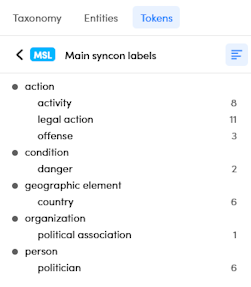
Only leaf items, if selected, are highlighted in the text.
To switch between the tree view and a row view, use the button to the right of the panel title bar  .
.

To look up a lemmas—or main lemma—or a syncon in the project's knowledge graph, hover over the item and choose Search lemma in knowledge graph or Search syncon in knowledge graph  . The list view of the knowledge graph navigator opens. In the case of a lemma, it is used as a search criterion and all the syncons for all the concepts that can be expressed with that lemma are shown.
. The list view of the knowledge graph navigator opens. In the case of a lemma, it is used as a search criterion and all the syncons for all the concepts that can be expressed with that lemma are shown.
To get information about a syncon, hover over the item and select Show information  . A pop-up appears showing information like the part of speech, the language, any gloss and the list of terms used to express the concept.
. A pop-up appears showing information like the part of speech, the language, any gloss and the list of terms used to express the concept.
For both Entities and Tokens:
-
To toggle the highlight of the occurrences of an item in the text, select and deselect the item.

Basic highlighting of the occurrences of named entities and token information is done using a dashed underline plus the abbreviation of the item type name below it. Both the underline and the abbreviation have the same color of the chip representing the item type in the right panel.
Multiple selection of items, possibly of different types, is possible, and doesn't require pressing
CtrlorShift.Note
Multiple selection can be managed for thesaurus projects in the Documents tab of the project settings.
To highlight all the occurrences of all the named entities of a given type, select the entity type.
The total number of selected items in both tabs is displayed in the upper right corner of the right panel
 .
.To de-select all the items, removing the corresponding highlights, select the X icon inside the counter.
-
To add an item to the search criteria and trigger a search, double-click the item.

The document list is updated.
Occurrences of the search criteria items are highlighted, but, compared to basic highlighting (see above), the text is bold and the item type abbreviation below the underline is boxed in a colored chip.
Other information
The other tabs in the right panel show information that is peculiar of the project type:
- Taxonomy for categorization projects
- Classes for extraction projects
- Thesaurus for thesaurus projects
Related documents
To toggle the display of a list of documents that are semantically related to the current document, select or deselect Show related documents in the ellipsis  dropdown menu. The list of related documents is displayed in the right panel.
dropdown menu. The list of related documents is displayed in the right panel.
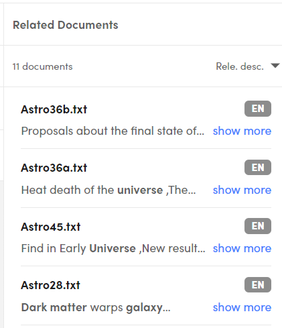
Select show more and show less beside the abstract of a document in the list or repeatedly select the abstract to toggle the display of a greater portion of document text.
To make a document the new selected document, double-click it.
To change the sort order select the preferred option from the dropdown menu at the top right.
Variants
Condensed document
Condensed document view shows only the portions of the text containing highlights. It's therefore only available if there are highlights.
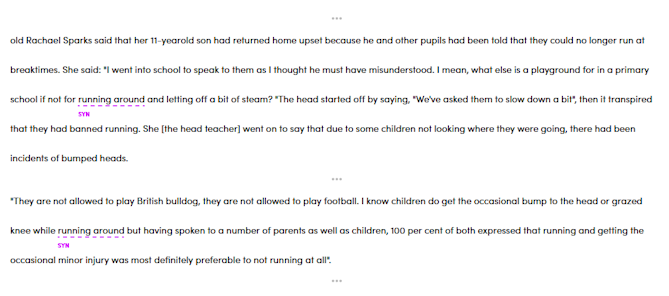
To toggle condensed view, select or deselect Show condensed document in the ellipsis  dropdown menu.
dropdown menu.
The highlighting of entities, tokens, classes values and concept expressions works as described above about entities and tokens.
If you highlight an item occurring in s that are not displayed, those phrases are added to the view.
Immersive view
The immersive view has more space for the document text doing without some elements of the GUI such as the document list on the left.
To switch to the immersive view, select Open immersive view  on the second bar.
on the second bar.
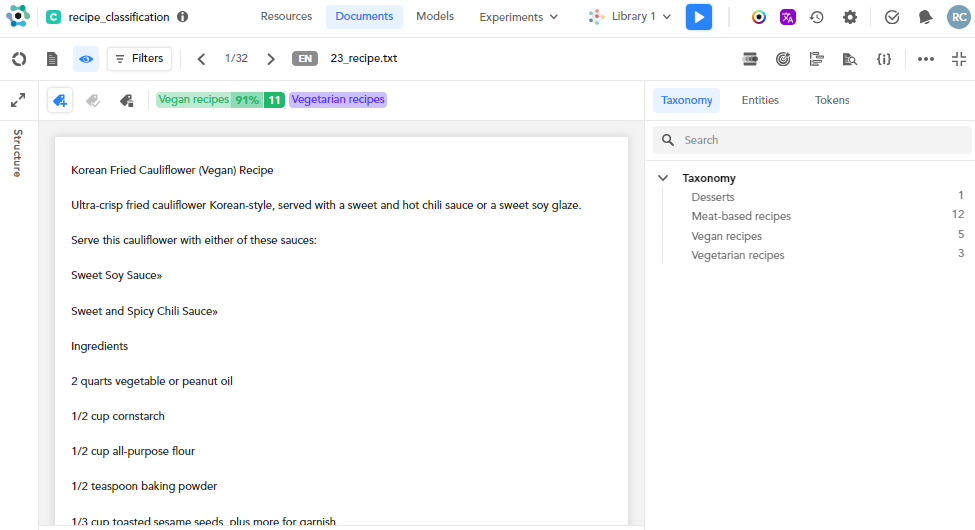
The immersive view also makes available the raw results of the NLU analysis carried out during document upload.
To display the analysis output, select Data model view  on the second bar. A JSON is displayed in the Data model tab. Another one is displayed in the Text and annotations tab showing generic information about the document, the document text and its annotations.
on the second bar. A JSON is displayed in the Data model tab. Another one is displayed in the Text and annotations tab showing generic information about the document, the document text and its annotations.

- To download the JSON of the selected tab, select
 on the panel toolbar.
on the panel toolbar. -
To expand and collapse the keys of the JSON of the selected tab:
-
Select Expand all
 and Collapse all
and Collapse all  on the panel toolbar.
on the panel toolbar.Note
Expand all
 and Collapse all
and Collapse all  are only available in the Data model tab.
are only available in the Data model tab.
Or:
- Expand and collapse the keys in the JSON by using the arrow buttons on their left.
-
-
To copy the JSON To the clipboard select Copy result to clipboard
 on the panel toolbar.
on the panel toolbar. - To restore the previous view of the right panel, select Document view
 on the second bar.
on the second bar.
To switch back to the detail view, select Close immersive view  .
.
The highlighting of entities, tokens, class values and concept expressions works as described above about entities and tokens.
PDF document view
PDF document view is an immersive view for PDF documents that shows a graphical rendering of the document. It's available only if the PDF document view option was enabled at upload time. In that case, it's the default visualization when you open a PDF document in detail view.

-
To toggle this view, select PDF document view
 .
. -
The highlighting of entities, tokens, classes values and concept expressions works as described above about entities and tokens.
The look of highlighted text is slightly different from other document views.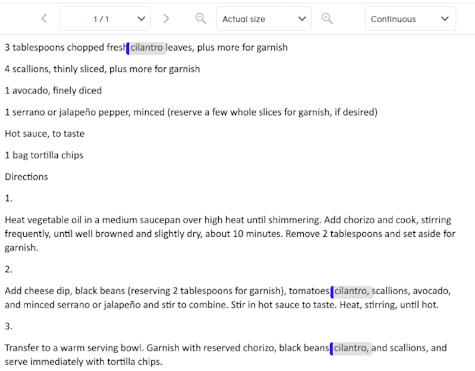
On the left of the highlighted area there's a color strip color corresponding to the color of the chip of the item in the right panel. To expand the strip to a chip corresponding to the item type, hover over the strip.

The chip is collapsed when you move the cursor away from the highlight.
The toolbar above the document allows you to navigate the document and control visualization.

-
To toggle the sidebar, which contains navigation thumbnails and the search box, select Toggle sidebar
 . Inside the sidebar:
. Inside the sidebar:-
To toggle the display of navigation thumbnails select Show thumbnails
 .
.
To go to a page, select its thumbnail. -
To display the search box select Show search
 .
.
To start the search type inside the box and pressEnter. The first page where the string occurs is displayed, with occurrences of the string highlighted in the text, and the sidebar disappears. To see the number of matches and a snippet of each match, select Toggle sidebar .
.
-
-
To scroll the document continuously you can use the scroll bar, the up and down arrow keys or the mouse wheel.
-
To scroll the document page by page:
- Use the
PageUpandPageDownkeys. -
Use the page control on the toolbar, which shows the current page number and the total number of pages:

- Select Previous page
 or Next page
or Next page  .
.
Or:
- Select the page number from the dropdown list.
- Select Previous page
- Use the
-
To zoom the document use the zoom control on the toolbar:

- Select the desired zoom level from the dropdown list.
Or, after you selected a percentage zoom level from the dropdown list:
- Select Zoom out
 and Zoom in
and Zoom in  to decrease or increase the zoom percentage.
to decrease or increase the zoom percentage.
-
To change the visual layout of document pages use the layout control on the toolbar:

You can choose between:
- Continuous: single page continuous layout.
- Presentation: single page layout.
- Magazine: side-by-side two page layout.
Note
In Presentation and Magazine layout you cannot scroll through the pages with the mouse.
Switch to other views
To switch to other views of current library's documents, use the toolbar of the left panel:
- Select Browse documents
 to switch to the list view.
to switch to the list view. - Select Analytics
 to switch to the analytics view. Learn about this view in the sections of this manual pertaining categorization, extraction, thesaurus and corpus projects.
to switch to the analytics view. Learn about this view in the sections of this manual pertaining categorization, extraction, thesaurus and corpus projects.